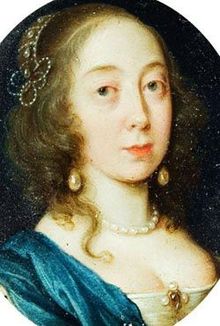Jane Cavendish
| Jane Cavendish | |
|---|---|
 |
|
| Born |
Jane Cavendish 1621 |
| Died | 1669 |
| Nationality | English |
| Other names | Jane Cheyne |
| Known for | Poetry |
Lady Jane Cavendish (1621–1669) was a noted poet and playwright. She was daughter of William Cavendish, Duke of Newcastle, and later the wife of Charles Cheyne, Viscount Newhaven, Along with her literary achievements, Jane helped manage her father's properties while he spent the English Civil War in exile; she was responsible for a variety of military correspondences and for salvaging many of her family's valuable possessions. Later in life, Jane became an important community member in Chelsea. She used her money and resources to make improvements on Chelsea Church and to otherwise benefit her friends and neighbours. Marked by vitality, integrity, perseverance, and creativity, Jane's life and works tell the story of a Royalist woman's indomitable spirit during the English Civil War and Restoration in England.
Born in 1621 to William Cavendish and his first wife, Elizabeth Basset Howard, Jane Cavendish grew up in a prosperous and loving environment. Much of the wealth that William possessed had been accumulated by his grandmother, the Renaissance property magnate Elizabeth Hardwick, Countess of Shrewsbury—better known as Bess of Hardwick. Bess's properties, her fortune, and her remarkable tapestries were important inheritances of William's family, and Bess herself provided a template of autonomous female behaviour for William's daughters. Throughout his life, William added to Bess's wealth and properties—in part by marrying Howard, who was a rich widowed heiress at the time of their marriage.
Adjacent to his social and monetary ambitions were William Cavendish's tremendous literary ambitions, which he aspired toward in his own writings but homed in on most thoroughly by developing relationships with a wide range of poets and playwrights including Ben Jonson, Thomas Shadwell, and John Dryden. Because of her father's literary and political connections, Jane's world was—from the start—replete in the excesses that typified Charles I's court. She had a number of elegant gowns, many made of sumptuous velvets, and a fine collection of garments and linens. More significant than these signs of her social standing, however, are some early traces of her literary development. In one of her father's manuscript books (now University of Nottingham MSS Portland Collection, Pw V 25:21–22), Jane responded to her father's couplet "Sweet Jane / I know you are a rare Inditer.— / And hath the Pen off a moste redye writer. / W.N." with the following lines: "My Lord / I know you doo but Jest with mee / & so in obdence I right this nothing / Jane Cavendysshe." It is worth noting that although William wrote similar couplets to each of his children, only Jane and one of her brothers recorded a response—and Jane’s is by far the cleverer of the two. Her father’s assessment of her as “a moste redye writer” carried over into her adult life, when she collaborated with her sister on some literary documents and also wrote her own poetry.
...
Wikipedia
